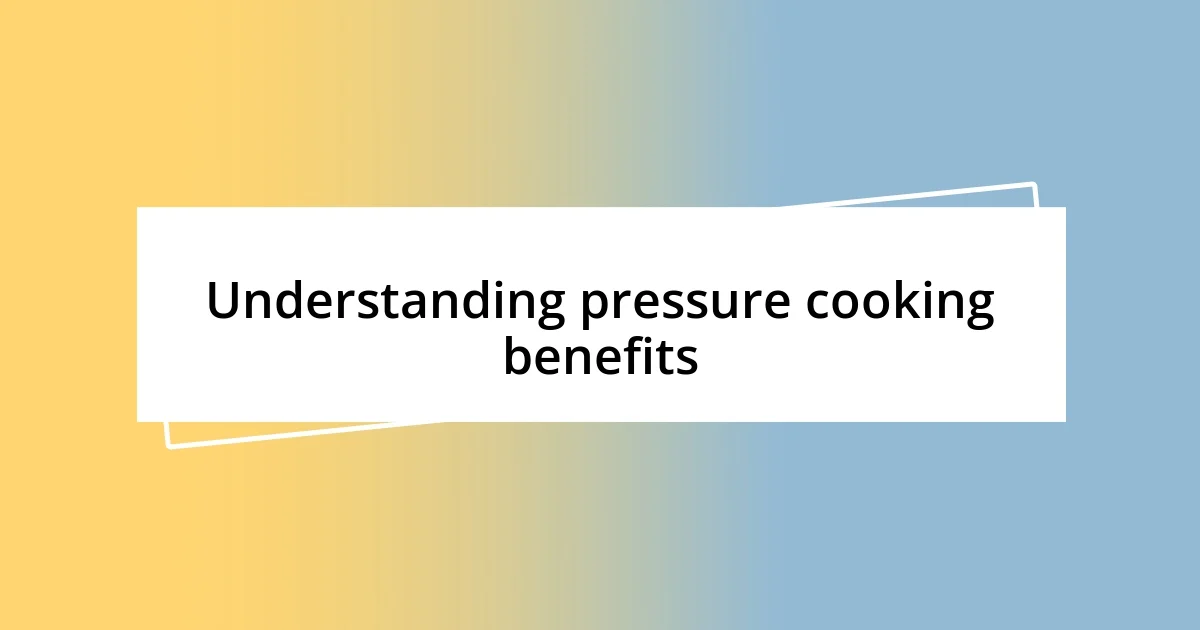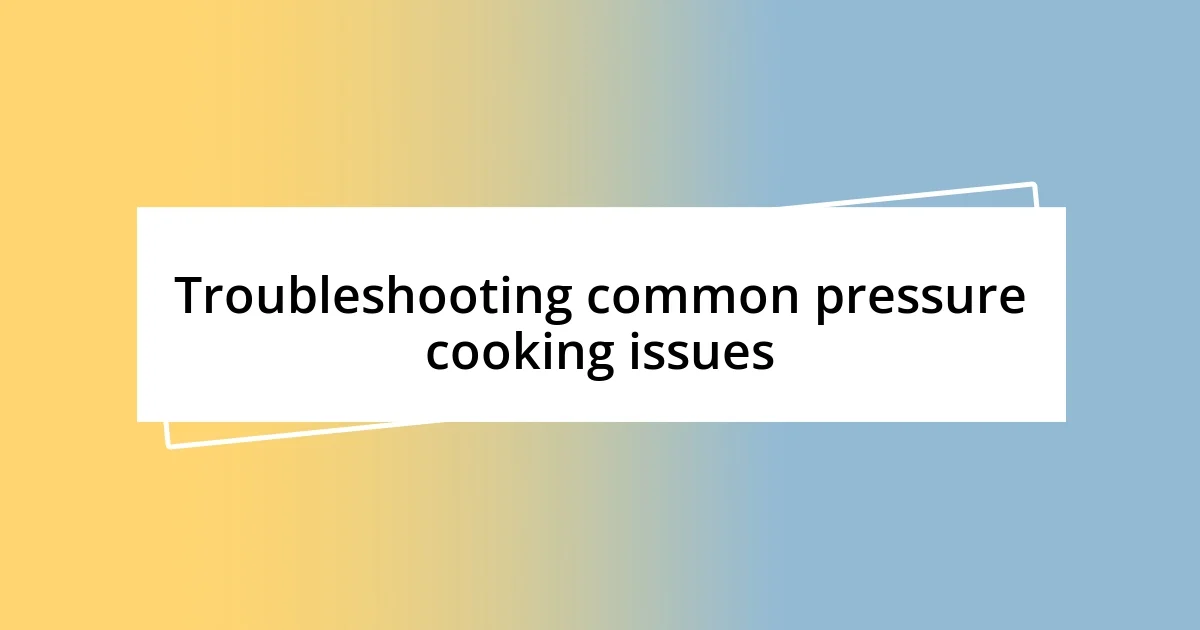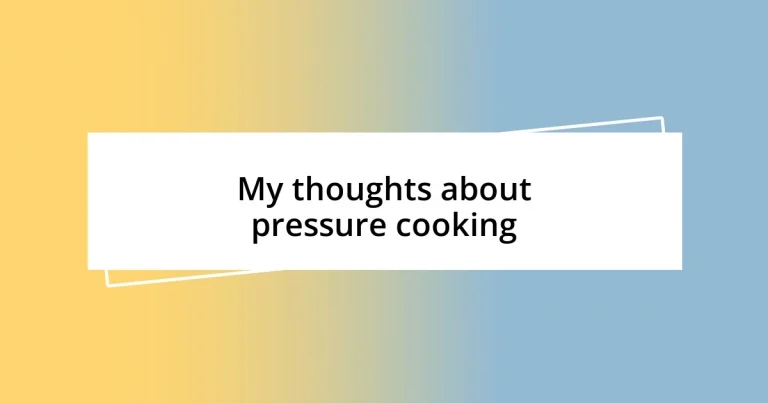Key takeaways:
- Pressure cooking significantly reduces cooking time while preserving nutrients and enhancing flavor, making it suitable for various meals, including desserts.
- Common misconceptions about pressure cookers include safety concerns, limitations to meat cooking, and incorrect assumptions about liquid requirements and cooking speeds.
- Choosing the right pressure cooker involves considering key factors like pressure settings, material quality, and size to fit personal cooking needs.

Understanding pressure cooking benefits
One of the most remarkable benefits of pressure cooking is how it dramatically reduces cooking time. I remember the first time I used a pressure cooker; I was preparing a risotto, which usually takes ages. Within a fraction of the time, I happily served a creamy dish that felt like it had simmered all day, and I couldn’t believe how tender the ingredients were. Isn’t it incredible that you can save time and still enjoy food that tastes like a labor of love?
Another advantage lies in the way pressure cooking preserves nutrients. When I transitioned from traditional cooking methods, I noticed that my meals were not only quicker to prepare but also packed with flavor and health benefits. Have you ever thought about how much goodness can be lost in boiling? Using a pressure cooker helps lock in those vital nutrients, ensuring that my family doesn’t just eat well, but stays healthy too.
Lastly, I find the versatility of pressure cooking truly exciting. From stews to desserts, the possibilities seem endless. Just the other week, I whipped up a chocolate lava cake within minutes—my kids were delighted! How often can you make a gourmet meal or dessert so quickly? It’s a game changer for busy lives and adds a fun twist to weeknight dinners.

Common pressure cooking misconceptions
Many people seem to hold onto certain misconceptions about pressure cooking. For example, there’s a belief that pressure cookers are dangerous and that they might explode. In my own experience, I’ve found that modern pressure cookers have so many safety features—like locking lids and pressure indicators—that they feel quite secure to use. The first time I used mine, I was a bit nervous, especially with all the stories I’d heard, but as soon as I got the hang of it, it felt like second nature.
Here are a few common myths that I’ve come across:
- Pressure cooking is only for meat: This is far from true! You can make grains, vegetables, and even desserts effortlessly.
- You can’t open the lid while cooking: Once you release the pressure, most models allow you to safely open the lid—experimenting mid-cook can lead to some tasty discoveries.
- All pressure cookers cook at the same speed: Different models and recipes can yield various cooking times; I’ve learned to adjust based on my cooker’s performance.
- You have to add a lot of liquid: While liquid is necessary, the amount often required is much less than most think; even a cup can be sufficient for many dishes.
- You can’t cook delicate foods: On the contrary, items like fish can be perfectly prepared in a pressure cooker if done correctly!

Pressure cooking vs traditional cooking
When comparing pressure cooking to traditional cooking, the speed difference is striking. I often recall my experience with making beans; in a traditional pot, it usually took hours of soaking and cooking. In my pressure cooker, I could have them ready in under 30 minutes. It was honestly eye-opening—saving time without compromising quality made me rethink my entire cooking routine.
The flavor retention in pressure cooking is another aspect I cherish. When I prepare a hearty stew, using a traditional method meant hours of simmering, which often dried out the ingredients. I once experimented by making the same stew in both methods. The pressure cooker resulted in a dish bursting with flavor, while the traditional one lacked that punch. Have you ever tasted what deep flavor that quick process can lock in?
Finally, the hands-on aspect of traditional cooking often provides a more intimate experience. I enjoy the process of stirring, tasting, and tweaking flavors as I go along. However, I must admit that when the pressure cooker does its magic, I feel a mixture of surprise and excitement at the results. It’s a unique balance. Ultimately, it comes down to what you enjoy in your cooking journey.
| Aspect | Pressure Cooking | Traditional Cooking |
|---|---|---|
| Cooking Time | Much faster, often reduces cooking time by up to 70% | Longer, can take several hours |
| Nutrient Preservation | Better at preserving nutrients due to reduced cooking time | Nutrients can be lost during longer cooking times |
| Flavor | Intense, rich flavors as ingredients cook quickly in a sealed environment | Depth of flavor developed through longer cooking and simmering |
| Hands-On Experience | Less interactive, meals done with minimal monitoring | More interactive, allows for constant tasting and adjusting |

Essential tips for pressure cooking
When I first started pressure cooking, I quickly realized that understanding the importance of liquid was a game-changer. The right amount—not too much or too little—can make a world of difference in achieving the perfect texture and flavor. I still remember the first time I experimented with less liquid than a recipe suggested. The result? A wonderfully concentrated flavor that really impressed my dinner guests. It made me wonder: how often do we overlook simple adjustments in our cooking?
Another essential tip I’ve learned is to allow for natural pressure release when cooking certain dishes, particularly tougher cuts of meat. It’s like giving the food a moment to relax and soak in all those flavorful juices. I recall my first attempt at pot roast; I was so eager to see the final result that I rushed through the release. The meat turned out a bit tough, and it made me think about how patience in cooking can lead to incredible rewards.
One thing that can really enhance your pressure cooking experience is experimenting with spices and aromatics. I like to layer flavors in my pot, perhaps adding garlic, herbs, and a splash of wine before sealing it all in. The first time I did this with a simple vegetable soup, the aromas that filled my kitchen were nothing short of magical. It left me reflecting on how pressure cooking can be not only a time-saver but also a way to elevate simple ingredients into something extraordinary. Have you ever put in that extra effort to create depth in a dish? The satisfaction is truly unmatched!

Choosing the right pressure cooker
Choosing the right pressure cooker can feel overwhelming with so many options available, but I’ve discovered a few key elements that really matter. When I decided to invest in mine, I prioritized a model with multiple pressure settings. This feature has allowed me to tackle a variety of recipes—everything from delicate vegetables to tougher cuts of meat—without worrying about compromising on texture or flavor.
I also learned that material plays a significant role in performance. My first cooker was stainless steel, and the difference in heat distribution compared to a non-stick model was noticeable. The stainless steel not only enhanced the flavor of my dishes but also felt sturdier during operation. Have you ever noticed how the right material can elevate your cooking experience? I certainly did, especially during those moments when my pot was working its magic on a rich quinoa dish.
Finally, I can’t stress enough the importance of size. Choosing the right capacity based on your family size or cooking habits can significantly alter your experience. I remember my surprise when I realized how quickly a bigger pot could turn a family gathering into a feast. It’s something to consider—after all, a pressure cooker should fit not just your kitchen, but also your lifestyle. So, what matters most to you in choosing your cooker? Think about it; the right choice can truly transform your cooking adventures!

Troubleshooting common pressure cooking issues
When troubleshooting common pressure cooking issues, one of the most frequent problems I encounter is that the cooker doesn’t reach pressure. This can happen if there isn’t enough liquid in the pot or if the sealing ring is damaged or improperly placed. I vividly remember a time I rushed through setup and forgot to check the ring—my pressure cooker simply sat there, making weird noises while I eagerly anticipated my meal. It was a lesson learned: always double-check your setup!
Another issue I’ve faced is food sticking to the bottom of the pot, which can lead to burning. To combat this, I’ve found that deglazing the pot after browning meats or sautéing vegetables helps incorporate those delicious browned bits into the dish. The first time I made chili, I neglected that step, and it was disappointing to scrape the charred remnants. Now, I remind myself that taking those extra moments to layer flavors can save both my dish and my sanity!
Lastly, if you notice steam leaking from the sides of your pressure cooker, it’s crucial not to ignore it. This usually indicates a problem with the sealing mechanism or a buildup of food particles. I can recall a cooking session where I was so excited about my stew that I didn’t inspect the unit; steam shot out, and I quickly learned that addressing these small issues can prevent disappointing messes. Have you ever experienced a similar mishap? I understand how frustrating it can feel, but taking the time to troubleshoot can make all the difference in your pressure cooking journey!

Delicious recipes for pressure cooking
One of my all-time favorite recipes for pressure cooking has to be a savory beef stew. I remember the first time I tried it; I was skeptical about how tender the meat would become in just an hour. To my surprise, the beef practically fell apart with a fork, bathing in a rich broth infused with herbs. It’s such a comforting meal, especially on chilly evenings—have you ever felt that satisfaction when the aromas fill your kitchen?
Another delightful dish that has earned a permanent spot in my recipe rotation is creamy risotto. The beauty of pressure cooking it is the simplicity: you don’t have to stand by the stove, stirring constantly. I recall a particularly hectic week when I whipped it up in just 10 minutes. Tossing in mushrooms, a splash of white wine, and a handful of Parmesan created a feast that even my family raved about. It’s amazing how convenience can deliver such restaurant-quality flavors right at home.
For something refreshing, I often prepare a colorful vegetable medley. I love how the pressure cooker retains the vibrant colors and nutrients of the veggies. Just last week, I combined bell peppers, zucchini, and green beans with a drizzle of olive oil and herbs. The result? A gorgeous side dish that brightened up my meal and took mere minutes to prepare. Don’t you just love when healthy cooking can be both quick and delicious?














